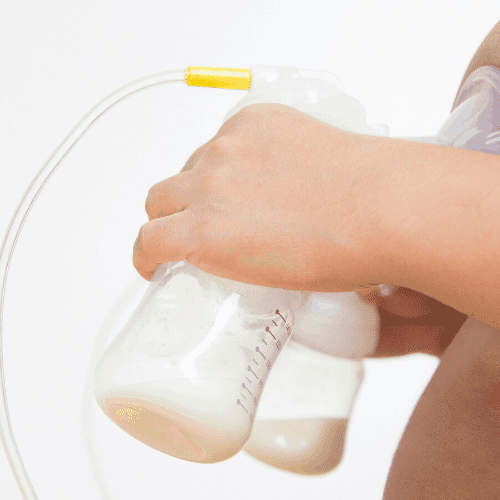Breast pumping is a positive experience for most women and often induces a feeling of pride and a sense of accomplishment. But pregnancy and breastfeeding also play havoc on your breast and nipples.
Throughout the trimesters you slowly come to terms with the changes in shape and size of your breasts; the darkening of your areolas and even the prominence of your veins.
So it can be very concerning when you use a breast pump, thinking your breast cannot possibly go through any more changes postpartum. Only to you discover you have what is known as elastic nipples. This realization can take away some of the joy and satisfaction a woman feels when she pumps. But it doesn’t have to.
As an Amazon Associate, I earn from qualifying purchases. The links below maybe affiliate links. Please read my disclosure policy for more information.

Although at first glance it can look quite worrying and feel uncomfortable, elastic nipples are very normal, and should not be a cause for concern.
So what are elastic nipples? Elastic nipples refer to when the nipple extends to the end of the flange tunnel (the funnel you insert your nipple into) when using a breast pump.
The nipples extend due to a hormone called Relaxin. This hormone increases both during pregnancy and afterward. It is responsible for the stretch in a woman’s hips and pelvic floor as well as the stretch in a woman’s nipples. This elasticity is important as it allows your newborn baby to latch on properly, drawing your nipple into their mouth.
A woman will be able to instantly feel the difference if her baby is not latching on to the nipple correctly. It turns an ordinarily painless process into one of great discomfort and pressure.
The same discomfort can be experienced when a woman uses a breast pump incorrectly.
If you opt to exclusively pump from birth it can be a daunting process using one for the first time. Breast pumping should not hurt as a whole. A woman might find slight discomfort in the first 10 – 15 seconds as her breast first releases milk, this is known as ‘letting down’.
This experience has often been described as feeling like pins and needles. As long as she is using the correct shaped flange and has it positioned correctly, it should be pain-free after that initial let down of milk.
The question commonly asked on breastfeeding forums is ‘How do I know if I have elastic nipples?’ Watching your breasts swell up during pumping and protrude quite significantly afterward can seem quite disconcerting.
Especially if this is your first child and you have not seen this happen before. It can be hard to know the difference between what is normal and what is not.
As a general rule of thumb if your nipples appear to stretch to 3 times the length, touching the end of the flange when pumping, then you are considered to have elastic nipples.
It is important to note that to be diagnosed as having elastic nipples, your nipples need to extend 3 times the usual size. In a flange that is measured to be 2 – 4 mm longer than your pre breastfeeding nipple length.
This is where ensuring you have the correct equipment is important. If it is not measured correctly and a flange is too small for your nipples then, not only will you start worrying you have elastic nipples, but you will find breast pumping very uncomfortable.
It may even go as far as disrupting your supply of milk. Women who experience elastic nipples are often met with pain, swelling, and dry or cracked skin regularly as they try to pump.
So you have elastic nipples, What can you do to ease the discomfort?
Generally, elastic nipples are not a cause for concern but you may find that it is affecting your milk output. So look for ways to minimize this.
Here are our top tips to take the frustration out of pumping,
Change the flange size on your pump
Having a flange that is too big can cause your nipple to be sucked rather uncomfortably into the funnel. A flange that is too small will cause your nipples to rub against the sides of the tube.
Using a measuring tape simply measure the diameter of your nipple, do this in millimeters. You only need to measure your nipple not the surrounding areola and whatever the measurement happens to be, add 4 millimeters onto it.
So for instance, if your nipple measures 30 millimeters across, then the flange size you need to be looking for is 34mm.
As every woman knows, breasts are not the same shape or size. So make sure you measure both because you may find you need two different shaped flanges!
If you struggle to find the exact size for your nipple then opt for the next closest size up, do not buy smaller.
Swap out plastic for silicone
Most breast pumps are made out of plastic. Whilst these can work well for some mums, others find the texture too harsh on their breasts. This is particularly true for women with elastic nipples.
Who find the plastic quite uncomfortable as their skin stretches inside it. This does not have to be the case, you can buy silicone flanges that fit over the funnel and add an extra cushion. Here are three popular silicone options,
- “Pumpin Pals” According to popular mum blogs these are a favorite for women who suffer from elastic nipples. The silicone funnel is tapered to offer a comfortable fit without restricting milk flow. On the company website, you can buy a multipack of three different sizes to fit your breasts as they change shape and size postpartum.
- “Beaugen Cushions” These soft inserts are designed to fit your existing breast pump and add extra comfort. They arrive flat and you simply tease them into shape and fit them inside your flange, the sticky plastic then creates a seamless seal. The cushions reduce the diameter of your flange by 2mm so you will need to bear this in mind when choosing the right fit.
- “LacTech Baby Motion Flange” – The silicone on these funnels is semi-transparent. They are designed to give you a little extra privacy should you find yourself pumping in a public place. This particular design boasts of being developed using ‘biometrical studies of babies nursing’. That maximizes the amount of milk produced and keeps your supply full and regulated.
Adjust your vacuum strength
As well as making changes to the size and material of your breast pump shields. You may find an improvement from experimenting with vacuum settings. To mimic babies suckling and encourage your milk flow you should aim to start slow and then gradually increase the strength to the point where you start to feel discomfort.
If you start to experience harsh pain or discomfort you likely have the settings too high. It can be a common misconception amongst new mums that the higher the vacuum strength the more milk you will produce.
To maximize your milk expression find the setting that begins to feel uncomfortable, then reduce the strength down one notch. Once you have emptied your breasts, dial the settings back down to the slow massaging setting you used at the beginning. To catch the final drips.
Lubricate your breast shield
Often women with elastic nipples will still experience some discomfort from breast pumping even with the correct size flange. This is most likely due to friction and is an easy issue to fix.
Whilst you may be tempted to turn to your nipple cream, most of these protective creams are thick and could cause gunk to build-up in parts of your pump. The recommended substance is coconut oil. This will effectively lubricate your breast pump funnel and also does wonders for your skin.
The changes to your body postpartum can be almost as frightening as though you experience during pregnancy and the birth of your new baby. But not all of them have to be a reason to worry.
Elastic nipples might appear strange the first time you breast pump but won’t affect your health in any way. Nipples are designed to stretch for your newborn to latch on correctly. So a little extra stretch does not have to turn your breast-pumping experience into a negative one.
With a few simple steps in place; correctly measured equipment and a good stash of coconut oil at your disposal you can eliminate any discomfort felt whilst pumping.
Elastic nipples do not have to be a cause for a disruption in your milk supply. If you find that it is then tinker around with different pumps and flange sizes until you find a fit right for you.
Once you have eliminated the discomfort you can get back to focusing on that sense of pride and accomplishment every woman should feel whilst expressing milk.
Feeding your baby from your supply should only be a positive experience and why should a few stretchy nipples affect that!











